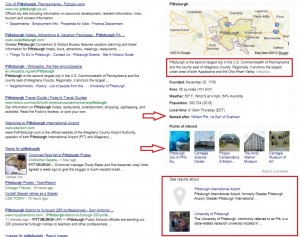| Jun 1, 2012
Google Knowledge Graph Creates a Pathway Towards Semantic Search
Depending on how closely you inspect Google search result pages, you may have noticed a recent change in the way some results are displayed. For a certain set of popular search queries – mostly recognizable people and objects like authors, actors, movies, landmarks, etc. – Google is now giving us a peek inside its Knowledge Graph, a complex map of “more than 500 million objects, as well as more than 3.5 billion facts about and relationships between these different objects.”
What does Knowledge Graph provide for the average searcher? It offers a one-stop shop for the most popular pieces of information about queries. The facts, images, lists, maps, etc. are presented inside a box on the right-hand side of the search results, which shows off Google’s intelligence about how people typically search. What do people want to know? What are related searches? What are similar results? Instead of having to click through to a destination site to find the answers you’re looking for, the answers are right in front of you.
The screen shot above (click to enlarge) includes the Knowledge Graph result for “Pittsburgh.” You can see a Google Maps result, a small detail paragraph pulled from the Pittsburgh Wikipedia page, some fun facts, points of interest around town, and a couple links at the bottom that are Google’s best guesses for what else you might be looking for when you search for Pittsburgh. One interesting note here: none of these links, with the exception of Wikipedia, link out directly to web pages. Each link that you see generates a new Google search on that highlighted term.
Here’s another shot of the result for “Steelers” (out of season but never out of mind…). This result demonstrates the integration the Knowledge Graph is providing for Google+. The image at the top leads you to the Steelers Google+ profile, and that profile’s most recent post is also being highlighted near the middle. Again, no links are going outside of Google properties except for the Wikipedia link.
This search result format is pretty nice but not necessarily a game-changing addition. Or, is it?
What this change implies is that Google is beginning to display a semantic search capability, one that’s eluded the search giant throughout the years. Semantic search seems like a fairly simple idea on the surface, but it’s one that’s complicated to execute. How does a search engine understand the intent behind searches? Or, the relationships between them? Can it answer questions that are asked instead of delivering results based on only the words in the question? For queries with many potential meanings, which result should be delivered first? For queries with numerous synonyms, should any be shown?
When you think about the insights that could be gleaned from the enormous volume of search queries (more than 3 billion per day, according to comScore) Google is sitting on, it’s bound to provide actionable intelligence. What’s been learned from Google users’ clicks and subsequent searches performed over the years?
Implications for Keyword Targeting
We’ve always focused very heavily on the importance of a keyword’s halo effect. When we decide to pursue a particular key term on behalf of a client or for ourselves, we consider how much additional traffic could be generated once we’re successful in getting that term ranked. How many related terms do we think will rise up in the rankings and bring visitors? Now, with a glimpse into the future possibility of semantic search, we can take that thinking to a new level. It won’t be as simple as matching words in a query to those exact words on a site. What is a query truly asking? Google’s thinking – and, consequently, ours – will become much broader.


